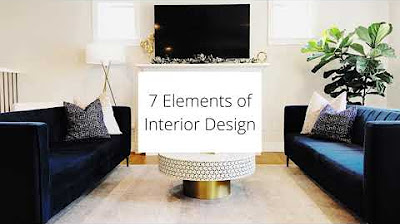THE 7 ELEMENTS OF INTERIOR DESIGN EXPLAINED | CREATE THE PERFECT SPACE
Summary
TLDRIn this video, interior designer Pizzati Ali discusses the seven essential elements of interior design: space, color, light, texture, pattern, line, and form. She emphasizes the importance of balancing negative and positive space, understanding color psychology, and utilizing different types of lighting to set moods. Ali also highlights the role of texture in adding depth and the strategic use of patterns and lines to guide the eye and create movement. Lastly, she touches on the significance of form in achieving harmony and balance in a space.
Takeaways
- 📝 Interior design is a science that involves principles and elements to create aesthetically pleasing spaces.
- 📝 The video discusses the seven elements of interior design, which are crucial for balancing a space.
- 📝 The first element, space, involves working with three-dimensional areas and includes both positive and negative space.
- 📝 Color is a powerful tool in interior design that can affect mood, psychology, and the perceived size of a room.
- 📝 Light, both natural and artificial, is essential for highlighting other design elements and setting the mood.
- 📝 Texture adds interest and depth to a space and comes in visual and actual/tactile forms.
- 📝 Patterns, created by repetitive designs, can add appeal to a room but should be considered for scale and style.
- 📝 Lines guide the eye and shift the room's focus; horizontal, vertical, and dynamic lines serve different purposes.
- 📝 Form relates to the physical appearance of three-dimensional objects and should consider scale and proportion.
- 📝 Balancing all these elements effectively is key to creating a beautiful and functional interior space.
Q & A
What are the seven elements of interior design mentioned in the script?
-The seven elements of interior design mentioned are space, color, light, texture, pattern, line, and form.
How does the balance between negative and positive space affect interior design?
-Striking a balance between negative and positive space helps to avoid clutter and overcrowding while also preventing sparseness, thus creating an aesthetically pleasing interior.
What is the significance of color psychology in interior design?
-Color psychology is significant in interior design because it affects our moods and can make rooms seem larger or smaller. It's important to consider the room's function and the activities that will occur there when choosing colors.
How does light impact the perception of color in a room?
-Light is critical for perceiving color as it allows us to see the colors we've chosen. Without light, colors disappear, and everything turns black.
What are the different types of lighting mentioned in the script?
-The script mentions man-made and natural lighting, and further categorizes lighting into accent lighting, task lighting, and mood lighting.
Why is texture important in interior design?
-Texture adds interest and depth to a space, making it visually pleasing. It comes in two forms: visual texture, which is perceived by the eye, and actual or tactile texture, which can be both seen and felt.
How can patterns affect the feel of a room?
-Patterns can add appeal to a room, but too much pattern in a small space can be overwhelming. Patterns should be chosen carefully considering the size and style of the room and should ideally be drawn from the same color scheme.
What are the three types of lines used in interior design?
-The three types of lines are horizontal lines, which give a sense of stability; vertical lines, which evoke strength and can make a room feel larger; and dynamic lines, such as curves and diagonals, which create movement.
How does form relate to the physical appearance of objects in interior design?
-Form relates to the physical appearance of three-dimensional objects and can be geometric, with hard lines and square edges, or natural, with organic forms. The scale, proportion, and repetition of forms are important for creating harmony and balance in a space.
What is the role of space in interior design according to the script?
-Space in interior design refers to the three-dimensional areas that make up a room, including length, width, and height. It's crucial to work within the physical boundaries of a room and balance negative and positive space for effective design.
How does the script suggest using color to affect the mood of a room?
-The script suggests that colors can evoke different emotions and memories, and can even affect physiological responses like blood pressure. It advises considering the room's function and the activities that will occur there when choosing colors.
Outlines

此内容仅限付费用户访问。 请升级后访问。
立即升级Mindmap

此内容仅限付费用户访问。 请升级后访问。
立即升级Keywords

此内容仅限付费用户访问。 请升级后访问。
立即升级Highlights

此内容仅限付费用户访问。 请升级后访问。
立即升级Transcripts

此内容仅限付费用户访问。 请升级后访问。
立即升级浏览更多相关视频

7 Elements of Interior Design

The 7 formal elements of photography

9 Design Elements You Need To Know In Under 360 Seconds

1 2 Elemen Desain

WHAT IS AN INTERIOR ARCHITECT ? // Interior Design vs. Interior Decoration vs. Interior Architecture

‘Shape’ Visual element of Graphic Design / Design theory Ep4/45 [Beginners guide to Graphic Design]
5.0 / 5 (0 votes)
